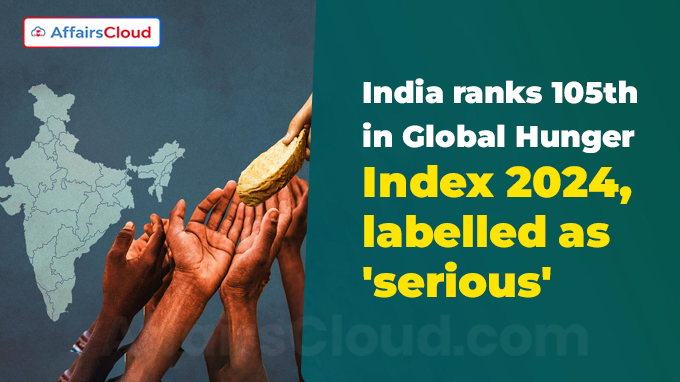 According to the 19th edition of ‘Global Hunger Index (GHI 2024): How Gender Justice Can Advance Climate Resilience and Zero Hunger’, India has been ranked at 105th position among 127 countries with an overall score of 27.3. India has improved its ranking by 6 places, from 111th (2023).
According to the 19th edition of ‘Global Hunger Index (GHI 2024): How Gender Justice Can Advance Climate Resilience and Zero Hunger’, India has been ranked at 105th position among 127 countries with an overall score of 27.3. India has improved its ranking by 6 places, from 111th (2023).
- As per the report, India is among 42 countries that have been placed under the “serious” category for hunger levels, alongside Pakistan (109th) and Afghanistan (116th).
- While, other South Asian neighbours of India such as Bangladesh (84th), Nepal (68th) and Sri Lanka (56th) demonstrated better GHI scores were listed under the “moderate” category.
About GHI:
i.The Global Hunger Index (GHI) is a tool used by international humanitarian agencies to measure and track hunger levels with GHI scores based on under-nourishment and child mortality indicators across 127 countries.
ii.The GHI is published by Irish humanitarian organisation Concern Worldwide and German aide agency Welthungerhilfe (WHH), with an aim to trigger action to reduce hunger around the world.
Highlights :
i.The report highlighted that global progress in reducing hunger has stagnated since 2016, thus, making the chances of achieving the United Nations (UN) Sustainable Development Goal (SDG) of Zero Hunger by 2030 increasingly unlikely.
ii.As per the report, around 733 million people face hunger each day due to lack of access to a sufficient amount of food, while about 2.8 billion people cannot afford a healthy diet.
- It highlighted that some of the African nations are on the extreme ends of the GHI spectrum under the “alarming” category. It outlined that wars in Gaza and Sudan have led to exceptional food crises.
- Also, conflict and civil strife are generating food crises elsewhere including the Democratic Republic of the Congo, Haiti, Mali and Syria.
Methodology:
i.GHI is based on the values of 4 key indicators that together capture the multi-dimensional nature of hunger which includes:
- Undernourishment: It is the share of the population whose caloric intake is insufficient.
- Child stunting: It is the share of children under the age of 5 who have low height for their age due to “chronic” undernutrition.
- Child wasting: It is the share of children under the age of 5 who have low weight for their height due to “acute” undernutrition.
- Child mortality: It is the share of children who pass away before turning 5, which partly reflects the fatal mix of poor nutrition and unsafe environments.
ii.A GHI score is calculated for each country on a 100 point scale, reflecting the severity of hunger, where zero is considered the best possible score (no hunger) and 100 is the worst (high level of hunger).
iii.The share of indicators in GHI scores: undernourishment (1/3),child stunting (1/6), child wasting (1/6), and child mortality (1/3).
iv.The data used for the indicators have been sourced from various United Nations (UN) and other multilateral agencies, including the United Nations Children’s Fund (UNICEF), the Demographic and Health Surveys (DHS) Program, and the Food and Agriculture Organisation (FAO).
Global Scenario:
i.The 2024 GHI score for the world is 18.3, which is considered moderate, has decreased marginally from the 2016 GHI score of 18.8.
- This global score demonstrates wide variations in hunger by region.
ii.As per the report, 22 countries with 2024 GHI scores of less than 5 have not been assigned individual ranks, they have been collectively ranked 1-22.
- Name of these 22 countries are: Belarus, Bosnia & Herzegovina, Chile, China, Costa Rica, Croatia, Estonia, Georgia, Hungary, Kuwait, Latvia, Lithuania, Montenegro, North Macedonia, Romania, Russian Federation, Serbia, Slovakia, Türkiye, the United Arab Emirates (UAE), Uruguay, Uzbekistan.
iii.The report highlighted that hunger is serious or alarming in 42 countries out of 127 countries surveyed in 2024 GHI.
- Among these 42 countries, hunger is considered alarming in 6 countries such as: Burundi, Chad, Madagascar, Somalia, South Sudan, and Yemen.
- While, hunger is designated as serious in the remaining 36 countries (including India).
iv.The report showed that progress against hunger in 20 countries with moderate, serious, or alarmingly 2024 GHI scores, has largely remain stagnated i.e. GHI scores of these countries have declined by less than 5% compared to their 2016 GHI scores or have not changed at all.
- Also, hunger in 22 countries with moderate, serious or alarming 2024 GHI scores, has increased since 2016.
v.The report highlighted that 2024 GHI scores of 5 countries i.e. Fiji, Jordan, Libya, Syria, and Venezuela, are even worse compared to their 2000 GHI scores.
- The report noted that some small countries such as: Bangladesh, Mozambique, Nepal, Somalia, and Togo have reduced their GHI scores by more than 5% compared with their 2016 GHI scores, even if hunger in these countries remains too high.
vi.Top 5 worst performing countries: Somalia (127th), Yemen (126th), Chad (125th), Madagascar (124th), Democratic Republic of Congo (123rd).
India-Specific:
i.The report observed that India’s 2024 GHI score showed some improvement compared to its 2016 GHI score of 29.3, which also fell under the “serious” category.
- It noted that India has made considerable progress compared to previous scores of 38.4 (2000) and 35.2 (2008), both of which were categorised as “alarming”.
ii.The report showed that India continues to face severe challenges in child malnutrition, with the highest child wasting rate (18.7%) globally.
iii.India has significantly improved its child mortality rate since 2000, it has decreased from 9.2% (2000) to 2.9%(2024).
iv.The report noted that although the child stunting rate in India has reduced significantly from 51.0% (2000) to 35.5 %(2024), it is still alarmingly high.
vi.The undernourishment rate of India has decreased from 18.3% (2000) to 13.7% (2024).
Region Wise:
i.According to the report, Africa South of the Sahara is the world with the highest and most concerning hunger levels. The high GHI score is mainly attributed to the highest undernourishment rate, child mortality rates of any region by far.
- It observed that undernourishment rate rose sharply between 2015 and 2023, particularly in West and Central Africa due to recurring conflicts, economic challenges, increasing inflation, among others.
ii.The report noted that hunger remains serious in the South Asia region, reflecting undernourishment and continuously high child undernutrition, mainly due to poor diet quality, economic challenges and the increasing impacts of natural disasters.
iii.Hunger in Latin America and the Caribbean region is categorised as “low”. But still, it is the only region in the world where hunger has worsened since 2016, attributed mainly by rising food inflation, and fertilizer prices, increasing debt, among others.
iv.While, West Asia and North Africa region has been categorised as “moderate”, but the GHI score of this region has remained stagnated due to the overlapping effects of conflict, climate change, and trade shocks.
- The report found that despite challenges, the European and Central Asian region is mostly on track to achieve low hunger by 2030.
About Welthungerhilfe (WHH):
It is one of the largest private aid organisations in Germany, without political or religious affiliation.
President- Marlehn Thieme
Headquarters- Bonn, Germany
Established- 1962




